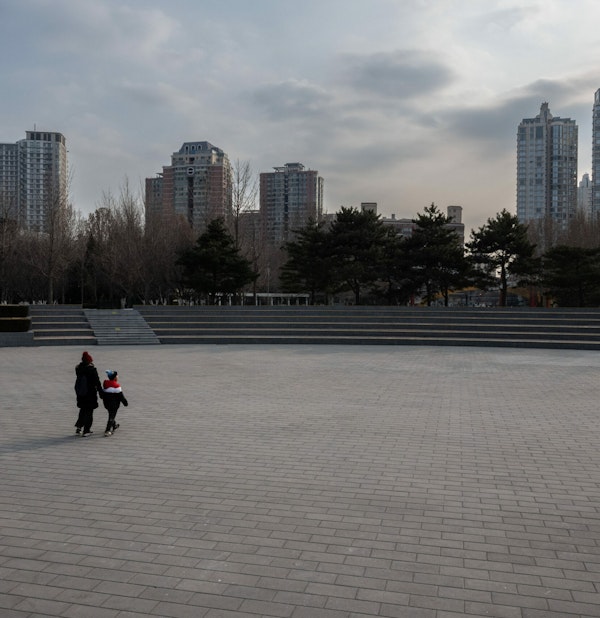The middling kingdom
China’s population is on track to shrink by half by the end of the century. Beijing must choose between reform and absolute power – it can’t have both.
 A woman and a child at a park in Beijing, China on January 20, 2024. (Photo by Bloomberg/Getty Images)
A woman and a child at a park in Beijing, China on January 20, 2024. (Photo by Bloomberg/Getty Images)
In July, on the 35th anniversary of World Population Day, the United Nations released a new report that reduced the world’s peak population prediction by 100 million – from 10.4 billion to 10.3 billion – and predicted that the Earth will reach that peak in 2084, two years earlier than previously thought. This is not the first time the U.N. has adjusted its forecast downward. In 2019, the organization projected a peak world population close to 11 billion, with growth extending into the 2100s.
A significant reason for the downsizing is China, which was not long ago the world’s most populous country. Two years ago, when China first reported that its population was beginning to decline, the U.N. projected that the country’s population could shrink by 45% by the year 2100, from today’s 1.4 billion to 771 million. Now the U.N. has cut its prediction for 2100 to 633 million. That difference of 138 million people is almost the size of Russia’s current population (144 million) and is larger than the current population of Japan (125 million).
The reduction can be attributed to the U.N.’s assumptions about the rate at which women in China are having children. For more than three decades now, China’s fertility rate has been below the replacement level of about two children per woman. When Beijing lifted its one-child policy in 2016, in place since 1980, the government hoped that fertility levels would rebound; instead, they have continued to decline. The government’s new pronatalist policy, which includes calling for couples to have three children, has had no discernable effect on birth rates. Instead, the fertility level has dipped to an ultralow rate of barely one child per woman. As a consequence, China now faces the daunting challenges that come with rapid population aging, such as a smaller young labor force and a growing elderly population. At the moment, about 15% of the Chinese population is 65 and older. That’s three times the size it was in 1990. In the next 25 years, this share is expected to double to 30%.
Hard choices
A smaller and older population will weigh on Chinese leaders as the challenges associated with such demographic shifts become increasingly pressing. How Beijing addresses these challenges will have far-reaching global geopolitical implications.
As Chinese health care and pension expenses rise alongside a rapidly swelling elderly population, the country’s leaders will have to make hard decisions – decisions they have mostly talked about in the past but avoided implementing. One example is China’s long delay in raising its official retirement ages (currently 60 for men and 55 for women), which were set half a century ago. As its population continues to age, the Chinese government will have no choice but to resort to raising taxes, curtailing benefits, or both. Leaders will also have to choose between funding pensions and medical expenses or increasing military and security spending. Over the past decade, spending on the former has increased faster.
These are hard constraints and hard choices. Failing to address them will threaten social stability and the government’s political legitimacy. When the government enforced a one-child policy, it implicitly promised to help with elderly support when the time came. That time has now arrived.
Increasing fiscal constraints in the wake of slow economic growth and rapid population aging are likely to temper China’s global ambition as well. The Chinese government will not enjoy the same excesses it had during the hypergrowth era to dish out generous foreign aid and fund extravagant projects overseas. Such constraints are also likely to impel the Chinese leadership to seek a more hospitable global political and economic environment for its economic growth imperatives.
 A construction worker in Beijing, China on January 24, 2024. (Photo by Bloomberg/Getty Images)
A construction worker in Beijing, China on January 24, 2024. (Photo by Bloomberg/Getty Images)
Indirect solutions
The solutions to China’s demographic challenges will not come from demographic legislation such as the one-child policy. Efforts by governments to raise fertility rates have proven futile, and not just in China. What China showed the last time it tackled a major demographic problem (its large and rapidly expanding population) is that the solutions lie in the economic and political spheres. Four decades ago, faced with a sluggish economy and a booming population, China didn’t solve the problem simply by limiting how many children a couple could have. Indeed, its extreme birth control policy turned out to cause far more troubles than it remedied.
What worked for China instead was abandoning its failed system of central economic planning and implementing liberalizing reforms. These reforms empowered individuals and families and unshackled the creative energy of the Chinese people, resulting in the so-called China miracle. Starting in 1979, household farming systems began producing far more food, rural industrial firms led to booming exports, and the massive migration of rural Chinese into the cities built up modern China. Between 1980 and 2020, per capita income rose nearly 30 times, from less than $450 to more than $12,000. With its economy booming, China no longer had to worry about having too many mouths to feed or too many hands to employ.
Today’s leaders should take a page from recent history in addressing their coming demographic challenges. Instead of returning to trying to directly manipulate birth rates, they should implement new economic and political reforms. In recent years, hubris stemming from its economic success has led the government to tighten its grip on society. Over the past two decades, and especially in the last one, the state has recentralized economic and political power. Complacency has replaced risk taking. Concerns over security and regime stability have become top priorities, overriding economic prosperity and social vitality. Decisions based on real and perceived security concerns often come with economic costs, which are routinely justified and cannot be questioned. A chilling international environment, partly fueled by nationalist and confrontational propaganda, has slowed down international exchanges, affecting foreign investment, trade, and even tourism. Foreign direct investment in China has been consistently falling for the past 12 months. Even after the end of the COVID-19 pandemic, Chinese overseas travel in 2023 was 40% below its pre-pandemic peak in 2019. The economy is clearly paying a price for politics.
 A medical worker attends to an elderly person in Huzhou, China on January 9, 2024. (Photo by Costfoto/NurPhoto via Getty Images)
A medical worker attends to an elderly person in Huzhou, China on January 9, 2024. (Photo by Costfoto/NurPhoto via Getty Images)
As in the past, concerns about unemployment have resurfaced. While the number of new people entering the labor market is shrinking, unemployment and underemployment are rising, even according to China’s official media. The lack of employment opportunities in China’s private sector is contributing to a slowing of economic growth. Biases protecting state-owned enterprises have boxed out private entrepreneurs, who have in the past been the main source of employment and economic growth. In the wake of the COVID-19 pandemic and an increasingly hostile environment for the private sector, many entrepreneurs have chosen to lie flat, no longer willing to take risks investing and expanding. College graduates now rush to apply for government and state-owned enterprise jobs. The Chinese government has paid lip service to reinvigorating the private sector, but so far it has yet to do so.
Yet Chinese cities still have great potential to increase employment and labor productivity. The best way to realize this potential would be by accelerating social policies to integrate the vast number of rural migrants who move to cities. In the last two decades, the share of China’s population classified as urban has increased dramatically, from less than 40% in 2000 to 65% today. Yet only about 45% of the population has local household registration, known in Chinese as “hukou,” which is required to access social benefits such as health care, pension, and certain educational opportunities for their children. That means that some 250 million people lack access to the social benefits enjoyed by their urban compatriots. They also cannot purchase local housing. Such policies, dating from the era of China’s planned economy, are not only socially unjust but also economically inefficient. Preventing migrants from officially settling in the cities makes them less likely to invest and contribute locally. In large cities, migrants need to rely on a point system – a system similar to those used by the immigration systems of countries like Australia and Canada – to qualify for local registration.
In July, the same month that the U.N. lowered its projection for China’s demographic future, China announced its latest set of reforms, which include relaxing further requirements to make integration easier. But vast differences still exist across Chinese cities – not only in income level but also in social benefits like pensions and health-care quality, which are paid out from local government coffers. Places with high benefit levels will be pressed to find the resources to shoulder the sudden increase in expenses if migration control is lifted totally. Instead of assigning local governments to pay for a central government mandate, what China needs to do is speed its efforts in establishing a national social security system that offers the same basic pension and health benefits to all its citizens in all its cities. Such a system will not only be socially just, it will also facilitate population mobility – mobility that can significantly contribute to economic growth.
China has entered a new demographic territory of decline. A longer lifespan is a blessing for individuals, but the challenge lies in adapting to a shifting age composition. No country has been able to slow or reverse population aging. China’s new population problem similarly has no demographic solutions. Instead, as was the case when China successfully solved its last population problem, the solutions to this new problem can only be found in reforming its economic and political institutions.
The Catalyst believes that ideas matter. We aim to stimulate debate on the most important issues of the day, featuring a range of arguments that are constructive, high-minded, and share our core values of freedom, opportunity, accountability, and compassion. To that end, we seek out ideas that may challenge us, and the authors’ views presented here are their own; The Catalyst does not endorse any particular policy, politician, or party.

